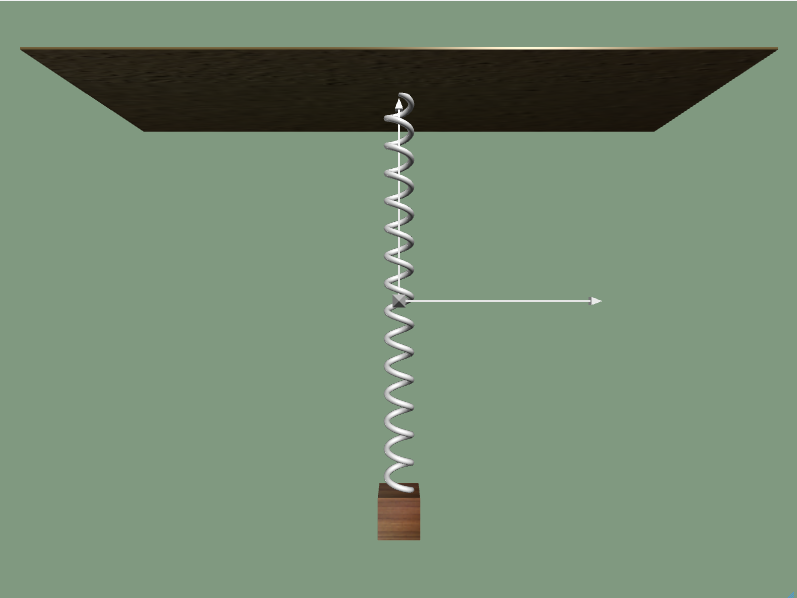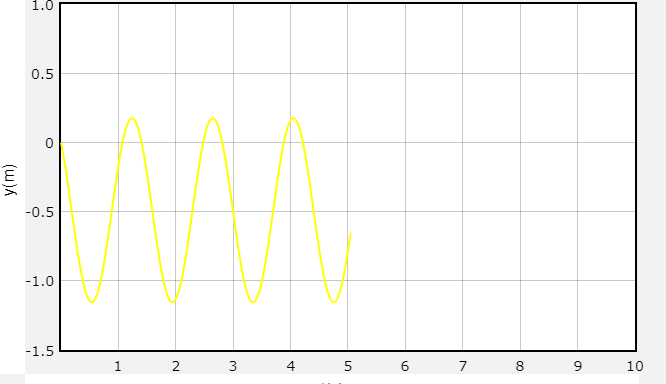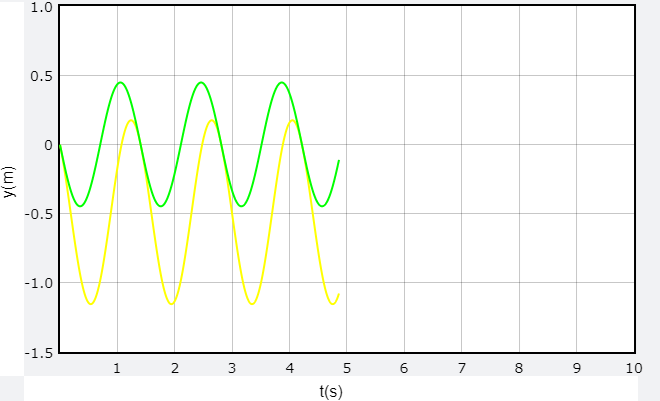垂直簡諧運動
-
在上一個課程「虎克定律」的案例中,我們是用 Python 程式來模擬「木塊」與「彈簧」之間存在的物理現象,這個課程換成是再加上「重力」,來探討「木塊」與「彈簧」之間的「垂直簡諧運動」。
畫出垂直懸掛的彈簧
Web VPython 3.2 # 匯入視覺化套件 from vpython import * # 1. 參數設定 # 重力加速度 g = vector(0, -9.8, 0) # 木塊質量 0.5 kg m = 0.5 # 彈簧的彈性性數 10 N/m k = 10.0 # 時間間隔 dt = 0.001 # 經過時間 t = 0 # 2. 畫面設定 # 畫布 scene = canvas(width=800, height=600, background=vector(0.5,0.6,0.5)) # 位置圖 gd1 = graph(xtitle='t(s)', ytitle='y(m)', ymax=1, xmax=10, ymin=-1.5) tx = gcurve(graph=gd1, color=color.yellow) # x軸箭頭 x_axis = arrow(axis=vector(1, 0, 0), shaftwidth=0.01) # y軸箭頭 y_axis = arrow(axis=vector(0, 1, 0), shaftwidth=0.01) # z軸箭頭 z_axis = arrow(axis=vector(0, 0, 1), shaftwidth=0.01) # 天花板 ceiling = box(length=3, height=0.01, width=1, texture=textures.stucco) # 木塊 square = box(length=0.2, height=0.2, width=0.2, texture=textures.wood) # 彈簧 spring = helix(radius=0.06, coils=15, thickness = 0.03) # 設定天花板位置 ceiling.pos = vector(0, 1, 0) # 設定木塊位置 square.pos = vector(0,0,0) # 設定木塊初速 square.v = vector(0, -2, 0) # 設定彈簧位置 spring.pos = ceiling.pos # 設定彈簧軸線(長度) spring.axis = square.pos - spring.pos # 設定彈簧原長 spring.L = spring.length # 3. 運動部分 while True: rate(1000) #彈簧的加速度 a= ( k / m ) * 彈簧的伸長量 * 彈簧的反方向 + 重力加速度 square.a = -(k/m)*(spring.length-spring.L) * spring.axis.norm() + g square.v = square.v + square.a*dt square.pos = square.pos + square.v*dt #更新彈簧的長度 spring.axis = square.pos-spring.pos # 畫出y軸位置圖 t = t + dt tx.plot(pos=(t, square.pos.y))執行結果


課堂作業
請畫出一個沒有受重力影響的「木塊」與「彈簧」,並且畫出「時間位置圖」。
執行結果


作業提示
# 木塊時間位置圖 gd = gdisplay(x=800, y=0, xtitle='t(s)', ytitle='y(m)', ymax=1, xmax=10, ymin=-1.5) ty1 = gcurve(gdisplay=gd, color=color.yellow) ty2 = gcurve(gdisplay=gd, color=color.green) # 3. 運動部分 while True: rate(1000) t = t + dt ...... # 畫出木塊座標時間位置關係圖 ty1.plot(pos=(t, square1.pos.y)) ty2.plot(pos=(t, square2.pos.y)) -